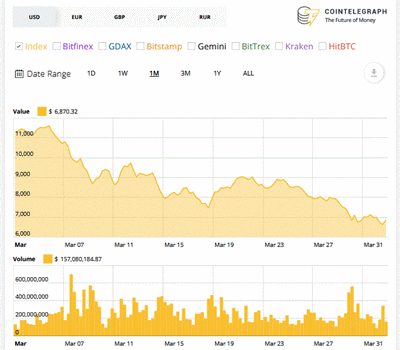The month of March saw a resumption of that 'steady downward trend'.
What other news for the month of March is worth mentioning? Here's one story that emerged at the end of February:-
- 2018-02-28: Is Bitcoin a Waste of Electricity, or Something Worse? (nytimes.com)
The long article explained that the positive dynamics of power generation are at risk of being usurped by bitcoin mining. Here are a few of the key points:-
Colin L. Read, the mayor of Plattsburgh, N.Y., also sees it as a public nuisance. The city was guaranteed a fixed supply of cheap electricity as part of the construction of power-generating dams on the St. Lawrence in the 1950s. Bitcoin mining companies are plugging into that power supply like a swarm of hungry mosquitoes. [...] Employers historically have created 30.5 jobs in exchange for each megawatt of low-cost electricity, according to the power authority, while Coinmint is proposing to create just new 10 jobs per megawatt. But 10 is more than none.
A few weeks later, the story evolved:-
- 2018-03-16: Bitcoin Mining Was Just Banned in Plattsburgh, N.Y. (fortune.com) • 'A small lakeside town in upstate New York is fed up with Bitcoin miners using up so much of its low-cost electricity. Plattsburgh, whose residents are a quick jaunt from the Canadian border, has put an 18-month moratorium on cryptocurrency mining to preserve natural resources, the health of its residents, and the “character and direction” of the city.'
- 2018-03-17: New York Authorities Crack Down on Bitcoin Miners Hunting Cheap Power (ditto) • 'The New York state Public Service Commission has ruled that power companies can charge higher rates to cryptocurrency mining operations, which have moved into the state’s north to take advantage of low-cost hydropower.'
Cryptocurrency mining is getting a critical look for different reasons, mostly negative:-
- 2018-03-02: Bitcoin heist: 600 powerful computers stolen in Iceland (nbcnews.com; Associated Press) • 'Some 11 people were arrested, including a security guard, in what Icelandic media have dubbed the "Big Bitcoin Heist".'
- 2018-03-04: Top Cyberthreat Of 2018: Illicit Cryptomining (forbes.com) • 'Due to a combination of a leaked NSA hack, a cryptocurrency more anonymous than Bitcoin [Monero], and benign cryptocurrency transaction processing (aka ‘mining’) software that requires no command and control link back to the attacker, we now have the perfect combination of easy money, slim chance of detection, and billions of unsuspecting targets that may not even care they’ve been hacked.'
- 2018-03-15: Bad news for bitcoin miners as it's no longer profitable to create the cryptocurrency (cnbc.com) • '"Bitcoin currently trades essentially at the break-even cost of mining a bitcoin, currently at $8,038 based on a mining model developed by our data science team," Fundstrat's Thomas Lee said in a report Thursday.'
Continuing with the negative slant on the bitcoin news, don't look to world class economists for any positive guidance:-
- 2018-03-02: Bitcoin faces regulatory crackdown, Bank of England warns (theguardian.com) • 'Cryptocurrencies inherently risky and fail most basic function as money, says Mark Carney [the Bank’s governor]'
- 2018-03-05: Bitcoin is based on the blockchain pipe dream (theguardian.com; Nouriel Roubini and Preston Byrne) • 'Overpriced cryptocurrencies owe their diminishing credibility to an over-hyped technology'
- 2018-03-06: Forget $100,000 bitcoin, says Kenneth Rogoff -- try $100 instead (marketwatch.com) • 'Regulation will bring down the price of the cryptocurrency within 10 years, the Harvard economist says.'
The silver lining in all this might be: What the Founding Fathers' Money Problems Can Teach Us About Bitcoin (smithsonianmag.com; April 2018) • 'Can you trust something that’s summoned into being, without a government backing it? As it turns out, this is precisely the conundrum that early Americans faced.' Meanwhile, in the 21st century bitcoin proselytizers run the risk of being branded criminals, probably because criminal activity is such a significant aspect of bitcoin lore:-
- 2018-02-28: Inside an Undercover Bitcoin Sting (time.com) • Jason Klein; 'guilty of failing to register as a money transmitting business with the federal government and to get a license from Missouri'
- 2018-03-20: The NSA Worked to “Track Down” Bitcoin Users, Snowden Documents Reveal (theintercept.com)
With so much bad news being associated with bitcoin and other cryptocurrencies, it's not at all surprising that an attempt at determining objective value is associated with the word 'misery'.
- 2018-03-09: Wall Street analyst creates new index that tries to tell you when to buy bitcoin (cnbc.com) • 'Bitcoin Misery Index'
- 2018-03-10: The Bitcoin Misery Index, BMI, Is Flashing A Buy Signal (forbes.com)
I'm tempted to start my own index: the 'Bitcoin Badnews Ratio', a contrarian signal. Let's see what happens in April. If the price trend is up, the BBR might actually have some merit.
